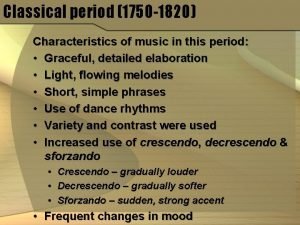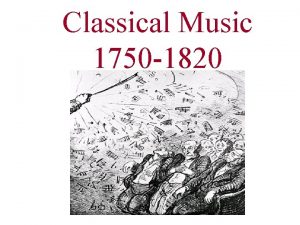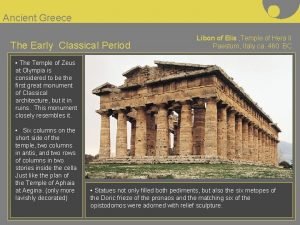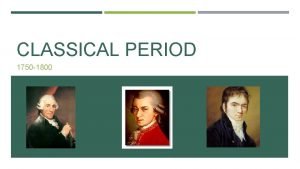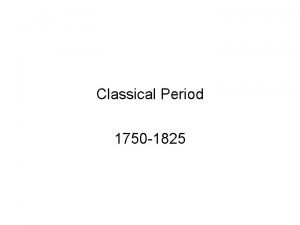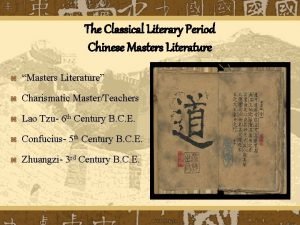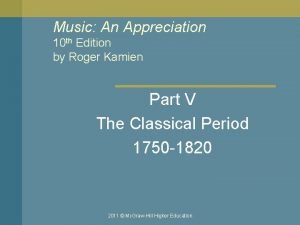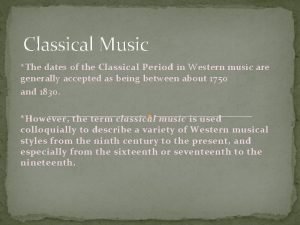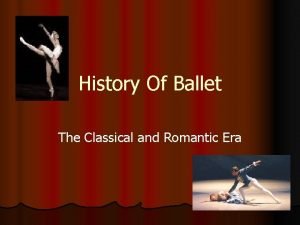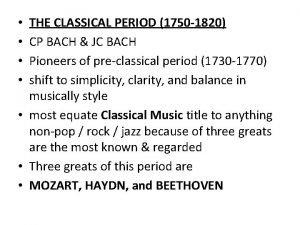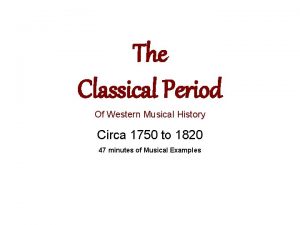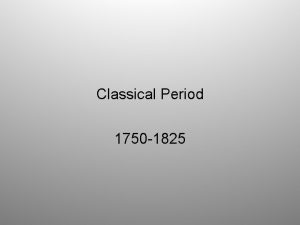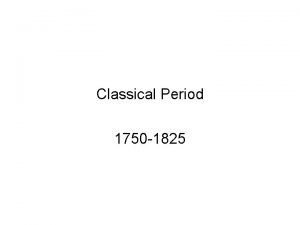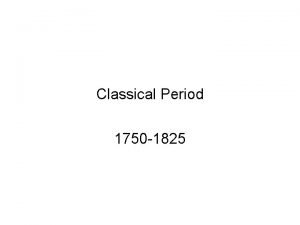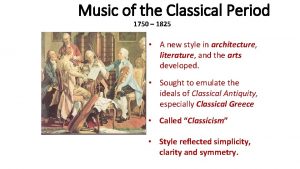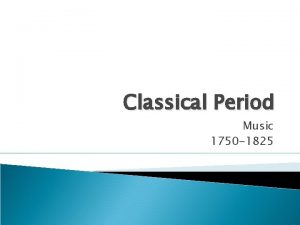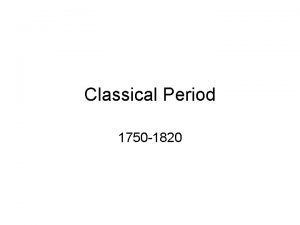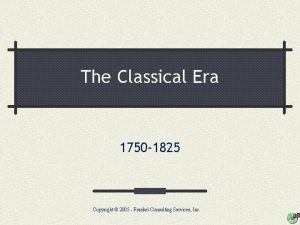The Classical Period c 1750 1825 1 The



















- Slides: 19

The Classical Period c. 1750 -1825

1. The Rococo Transition from late Baroque to early Classical period. Characterized by highly ornamented melody with slower moving harmonies (melody with harmonic accompaniment). Especially important development in France. J. S. Bach's sons figured importantly in this movement.

2. Sonata • Form which evolved from the dance suite in the classical period. For solo instrument(s) with accompaniment. • Consists of three or four large sections called movements, often still named for dances such as Allemande, Courante, Sarabande, Minuet, Gigue, etc. • Listening: Carl Phillip Emmanuel Bach’s Menuetto from Trio Sonata No. 20. Ex: Minuet (3 rd) sonata movement.

3. Sonata-Allegro Form • Used as the first movement of symphonies, sonatas, and string quartets. • Exposition- opening section in which composer reveals or “exposes” basic musical material. • Development- middle section in which composer reworks or “develops” basic material. • Recapitulation- restatement of exposition.

Jean Phillip Rameau • French late Baroque/Rococo composer who defined “functional harmony” and codified the tonic, subdominant, and dominant functions of chords.

4. Functional Harmony • Tonic- “home” harmony. Feeling of stability. • Subdominant- “away from home” harmony. Feeling of relative instability, but doesn’t usually proceed directly to “home” or stability. Tends to progress toward Dominant harmonies. • Dominant- “headed home” harmony. Feeling of strong instability. Tends to progress directly toward stable Tonic harmonies.

5. The Classical Period • Also called the Viennese School as the Austrian capital of Vienna became a cultural center in Europe. • Composers, including Haydn, Mozart, and Beethoven, came from all over Europe to study and work in and around Vienna, gradually developing the musical forms which would predominate European musical tastes for the next several decades.

6. The Classical Period • Composers embraced a clear, uncluttered style they thought reminiscent of classical Greece. • This style emphasized simple melodies, slower harmonic movement, and expression within widely agreed compositional practices (rules).

7. Alberti Bass • Classical practice of breaking harmonies (chords) into a repetitive arpeggiated pattern. • Listening: Luigi Boccherini’s (1743 -1805, Italian) “Menuet” from String Quartet Op. 13, No. 4. Ex: Alberti Bass.

8. Franz Josef Haydn 1732 -1809 • Early Classical composer. • Composed 104 symphonies, contributing significantly to the form. • Taught several important composers. Strongly influenced Mozart and Beethoven.

9 Symphony • Evolved from the dance suite in the classical period. • Often called a sonata for orchestra. • Large work in three or four movements (major independent sections) for orchestra. • Listening: F. J. Haydn’s Symphony No. 94, “Surprise”, 2 nd movement. Ex: symphony movement, theme & variation form.

10 Wolfgang Amadeus Mozart 1756 -1791 • Widely considered the greatest composer of all time and perhaps the greatest genius who ever lived. • Began composing at age 6. • Composed music in every genre then known, resulting in hundreds of works. • Contributed significantly to the development of the symphony, opera, instrumental sonata, and concerto.

Wolfgang Amadeus Mozart 1756 -1791 • Listening: W. A. Mozart’s Serenade No. 13 in G, Eine Kleine Nachtmusik, 1 st movement (Allegro). Ex: Classical sonata-allegro form (Exposition, Development, Recapitulation). • Listening: W. A. Mozart’s “The Queen of the Night” aria from Die Zauberflote (The Magic Flute). Ex: Classical opera.

Wolfgang Amadeus Mozart 1756 -1791 • Listening: W. A. Mozart’s Serenade No. 13 in G, Eine Kleine Nachtmusik, 1 st movement (Allegro). Ex: Classical sonata-allegro form (Exposition, Development, Recapitulation). • Listening: W. A. Mozart’s “The Queen of the Night” aria from Die Zauberflote (The Magic Flute). Ex: Classical opera.

11 Concerto • A three movement form for solo instrument with orchestral accompaniment. • The movements are ordered fast, slow, fast. • The first movement is sonata-allegro form with a double exposition (orchestra then solo).

12 Ludwig van Beethoven 1770 -1827 • German composer of the late Classical and early Romantic periods whose work illustrates the transition in style. • Studied work of Classical masters F. J. Haydn, W. A. Mozart, and Antonio Salieri in Vienna. • Composed nine symphonies. Other important works include piano (and other instrumental) sonatas, string quartets, an opera, and a mass.

13 Eroica Symphony • Beethoven’s 3 rd Symphony • At first dedicated to Napoleon Bonaparte. • He changed the dedication when Napoleon declared himself “emperor” and attacked Beethoven’s favored city, Vienna. • Uses single musical idea to unify movements thematically.

14 Beethoven’s Symphony th 5 • Beethoven is reported to have heard “fate knocking at the door” in opening motive. • This motive is important for unifying the entire first movement. • Listening: Ludwig van Beethoven’s Symphony No. 5, 1 st movement.

15 Choral Symphony • Beethoven’s 9 th Symphony. • So called (Choral) because he combines the forces of choir and orchestra. • Employs a single musical idea to unify the entire piece. Early use of a Romantic device. • Listening: Ludwig van Beethoven’s Symphony No. 9, “Choral. ” 4 th movement. Ex: early Romantic symphony.
 1750-1825
1750-1825 The classical period started from 1750 to 1872
The classical period started from 1750 to 1872 1750-1825
1750-1825 Franz joseph haydn characteristics of music
Franz joseph haydn characteristics of music 1820-1750
1820-1750 Ab 1825 supervisor definition
Ab 1825 supervisor definition 17 novembre 1825 a neuchâtel
17 novembre 1825 a neuchâtel Thaumatrope (1825)
Thaumatrope (1825) Opanaf 1825/2018
Opanaf 1825/2018 Farnese hercules
Farnese hercules Oath of the horatii characteristics
Oath of the horatii characteristics Classical period timeline
Classical period timeline Classical literary period
Classical literary period In the classical period serious composition was flavored by
In the classical period serious composition was flavored by What are the dates for the classical period
What are the dates for the classical period Romantic era ballet characteristics
Romantic era ballet characteristics Bach classical period
Bach classical period Characteristics of neoclassicm
Characteristics of neoclassicm Classical period orchestra
Classical period orchestra Metallic period 4 20 electrons
Metallic period 4 20 electrons



